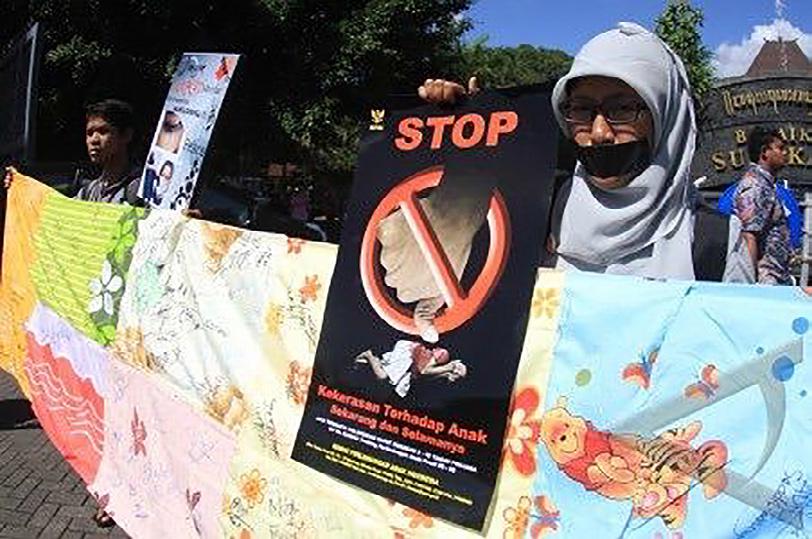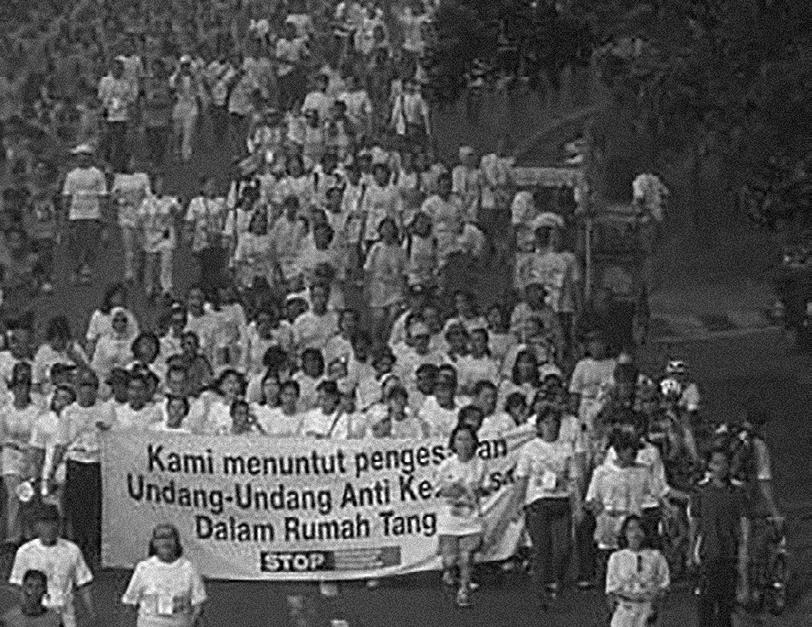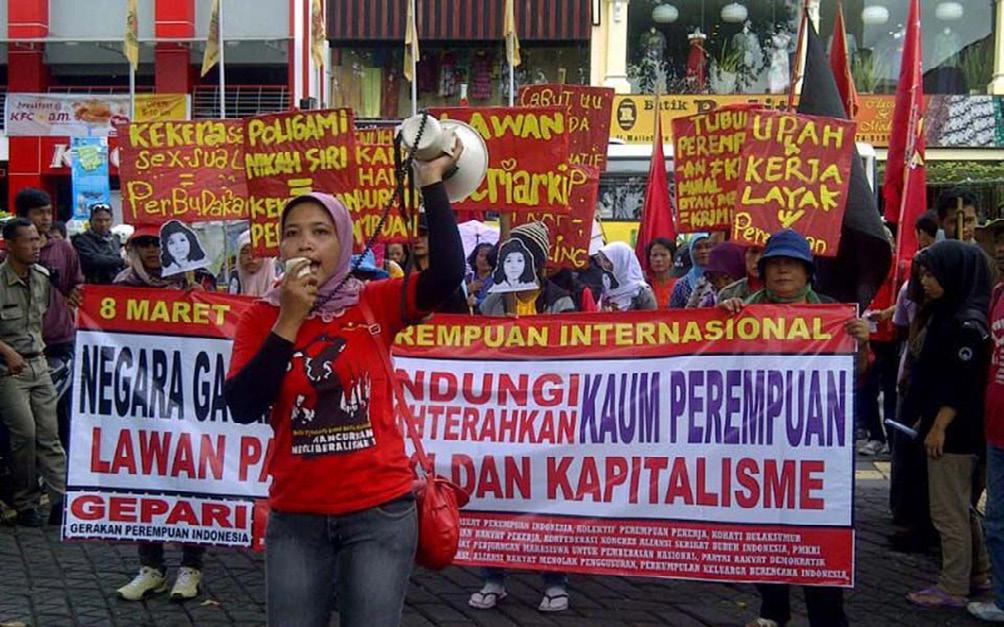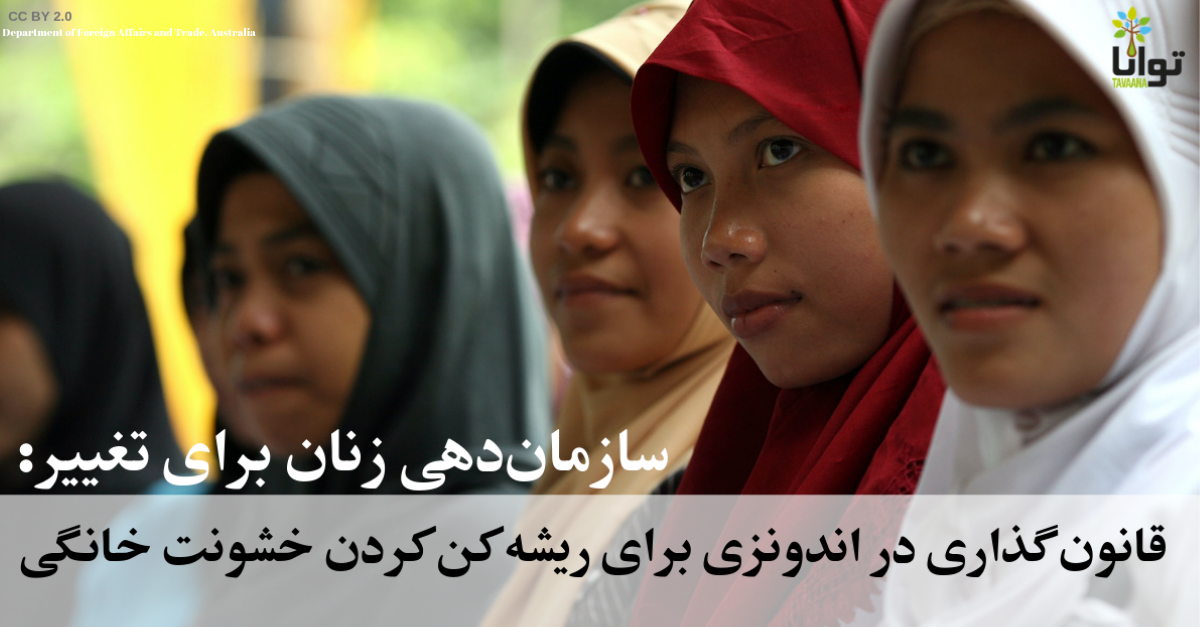Vision and Motivation
Violence towards women has long plagued Indonesia. In the late 1990s, during the final years of President Suharto’s (1966-1998) authoritarian regime, Indonesian women began mobilizing to address the problem. Domestic violence was considered a private issue, a belief reinforced by religious doctrines placing men at the head of the family. The Suharto regime’s gendered ideology stressed women’s “natural” role as wife and mother, and Suharto established women’s organizations to promote this view. Nonetheless, in the late 1980s, new NGOs emerged focusing on women’s rights and support for women who had experienced domestic violence.

Then in January 1998, country-wide riots broke out. This violence was triggered by skyrocketing food prices and fueled by sectarian violence. During these protests, there was widespread sexual violence towards women of Chinese dissent.[1] This violence continued until Suharto resigned in May 1998 and a slow transition to democracy began. The introduction of direct elections, greater local autonomy, the formation of new political parties, and greater freedom of press, speech, and association presented new channels for women to voice their claims and influence policy. Women’s organizations quickly seized on these opportunities, and many women were motivated to act upon hearing about the pervasive sexual violence during the protests. Mass demonstrations for women’s rights ensued and this, combined with the more open political environment, set in motion unprecedented efforts to advance women’s rights and freedoms.
Goals and Objectives
Although the Indonesian Criminal Code had penalties for physical abuse against women, they were rarely applied. Moreover, the criminal code did not recognize marital rape. Prevailing social attitudes prevented many victims from speaking out, and police were reluctant to process submitted reports of domestic violence. A key priority for activists was passing a law criminalizing domestic violence. Such a law would include a definition of domestic violence as physical, sexual, psychological, and economic abuse against all family members, including live-in domestic workers; protection and restraining orders against perpetrators of violence; and the provision of services to victims of violence, including counseling.
To achieve their goal of enacting legislation, women’s groups needed to raise awareness of domestic violence, change societal attitudes, and persuade key actors that government action was needed to combat domestic violence. To do so, they needed to form advocacy networks and alliances that would magnify their message and build support of domestic violence legislation. As one female activist stated, “What we were doing was changing a culture.”[2]
Leadership
The Women’s Association for Justice and Legal Aid (LBH APIK) led the national movement to enact legislation criminalizing domestic violence. In 1997, after aiding a domestic abuse survivor whose case attracted media attention, the organization began developing strategies to publicize the problem. This included organizing a workshop on domestic violence attended by representatives of women’s groups, academics, law enforcement officials, and religious leaders.[3]
Based on this workshop and a review of other countries’ laws, LBH APIK produced the first draft of an anti-domestic violence law for Indonesia. In 1998, after Suharto fell from power, LBH APIK held a second workshop on domestic violence. This led to the formation of the Advocacy Network to Eradicate Domestic Violence (JANGKAR), consisting of 15 women’s groups (including religious women’s organizations, groups providing assistance to victims, and women’s crisis centers). LBH APIK’s strategic leadership in the advocacy process helped form broader alliances, resulting in the creation of the National Advocacy Network to Eradicate Violence Against Women (JANGKA PKPT). This network became the key actor in mobilizing against domestic violence and the first to engage in advocacy with the state.
The leadership style of LBH APIK centered on building alliances and forging consensus. The initial network of women’s organizations, convened through LBH APIK, grew to encompass a range of civil society actors, including religious organizations; groups working for human rights, the environment, migrant workers’ rights, and other causes; the New Men’s Alliance (a national network of men supporting gender equality); professional associations; student groups; and, political parties. Activists built support for domestic violence legislation by framing the issue in terms that appealed to different groups’ interests and motivations. For instance, religious groups were persuaded to support the law with arguments rooted in Islamic principles of family harmony.[4] JANGKA PKTP leaders built support by consulting widely with network members and other groups on the draft law.
JANKGA PKTP activists also forged connections with government officials. In the aftermath of the 1998 May Tragedy and Suharto’s fall from power, women’s organizations pushed the government to establish a National Commission on Violence Against Women. The Commission’s mandate included public education, monitoring, fact finding, proposal writing, and building national, regional and international networks. JANKGA PKTP activists collaborated closely with the Commission to channel their demands for domestic violence legislation to state actors. This partnership led to the adoption of a National Action Plan for the Elimination of Violence Against Women in 1999-2000. In 2002-2003, JANGKA PKTP members planned a series of activities with the Commission to lobby parliament to support domestic violence legislation, such as creating information sheets on domestic violence available to all members of parliament. In addition to working toward legislation, female activists coordinating with government bodies at the national and local levels achieved programmatic innovations such as special service centers for women and children in hospitals.
JANKGA PKPT’s consensus-oriented leadership resulted in a revised version of the domestic violence bill that was strongly supported by all women’s groups regardless of their religious or class orientation. The bill was submitted to parliament in 2002, but required two more years of pressure on the government and parliament before the legislation was enacted in 2004.
Civic Environment
The end of President Suharto’s authoritarian regime in 1998 brought about a gradual transition to democracy. Suharto’s successor was his vice president and long-time crony, B.J. Habibie. Facing pressure for reform and demonstrations calling for his resignation, Habibie lifted numerous bans on freedom of expression and association, scrapped restrictions on political parties and scheduled elections for June 1999. Over ninety parties registered to compete in Indonesia’s first free elections in more than forty years. The victor was Abdurrahman Wahid, the leader of Indonesia’s [5] largest Muslim organization. Wahid represented moderate Islam and was considered a democratic reformer. Nonetheless, his leadership was erratic and corruption allegations led to his impeachment in 2001. He was succeeded by his vice president, Megawati Sukarnoputri, a moderate nationalist reformer. Megawati remained in office until new elections were held in 2004, the year the domestic violence law was enacted.
The relatively open political environment from 1998 onward enabled citizens to actively organize and advocate for their interests. Between 1998 and 1999, Indonesia progressed from a rating of “Not Free” to “Partly Free,” according to Freedom House assessments of civil and political liberties. Illustrating the changing nature of the relationship between government and society, within months of becoming president Habibie responded to demands from women’s organizations and created the National Commission on Violence Against Women. By the early 2000s, many effective and outspoken human rights groups existed. Women’s groups, previously concentrated around the capital, spread throughout the country. The media was vibrant and fairly free and the state generally protected and recognized the rights of civic, business, and political associations to organize and engage in advocacy.

Indonesian Women Campaigning Against Domestic Violence.
However, by the early 2000s, there were instances of government monitoring and interference with civil society organizations. Under President Megawati, the number of political prisoners increased due to a legal provision making it a crime to insult the president or vice president. Problems such as endemic corruption, ethnic and religious violence, and a volatile economy plagued successive governments. In 2004, Indonesia was ranked 133 out of 146 countries by Transparency International’s Corruption Perceptions Index. Nonetheless, the shift from “Not Free” to “Partly Free” in 1998-1999 opened a small window for citizens to demand basic rights and accountable governance. Activists made incremental progress and in 2006, for the first time, Indonesia earned a Freedom House rating of “Free.”
Message and Audience
The message of women’s rights activists was straightforward: violence against women is a public rather than a private matter, and it should be a criminal offense. Campaigns targeted multiple audiences in an attempt to change attitudes and build support for legal change. To reach and engage these different groups, a key strategy was to build broad networks. This, in turn, involved strategies of dialogue, negotiation, and bargaining. For example, network members thoroughly discussed and consulted over several years the initial legislation JANGKA PKTP drafted. While this took time and required compromise, it also strengthened unity, which contributed to the movement’s ultimate success.

Women demonstrating in favor of the law against domestic violence, Jakarta 2004. Komnas Perempuan.
In 2002, a member of parliament submitted the JANGKA-PKTP formulated bill to parliament. Ironically, parliamentary debate on the bill was postponed due to inaction on the part of Indonesia’s first female president, Megawati Sukarnoputri.[6] In response, JANGKA PKTP intensified advocacy efforts to get the legislation passed before her term ended, to avoid having to start fresh with a new parliament and government. As one female member of parliament explained, she “continually hounded” the relevant committee chairperson, telling him “this was a women’s struggle, and women needed this bill,” so it could not be set aside.[7] Using the leverage of their votes, female activists in the network said they would not support Megawati as a candidate for re-election unless she moved ahead on the legislation. At the same time, JANGKA PKPT organized mass actions such as the “umbrella demonstration,” where thousands of women held an umbrella to symbolize the protection the law would offer them, and lobbied political parties supporting the president. As parliament debated the legislation, female observers thronged the balconies in the building to show their support for it. Their efforts succeeded and parliament passed the Law on the Elimination of Domestic Violence in September 2004.
Outreach Activities

Kalyanamitra “Women Activists in Yogyakarta Commemorate IWD” Indoleft. 2014.
International and transnational organizations, development agencies and private foundations supported Indonesian women’s mobilization and advocacy efforts by providing funding and capacity building. For example, LBH APIK benefitted from its relationship with the Asia Pacific Forum on Women, Law and Development (APWLD), a regional network whose support and training helped them develop a legal analysis framework and led the national advocacy campaign for domestic violence legislation. International conventions and normative frameworks helped women legitimate and advance their demands. Indonesia ratified the Convention on the Elimination of All Forms of Violence Against Women (CEDAW) in 1980. Women’s NGO networks used CEDAW to hold the state accountable to its obligations with respect to women’s issues. The creation of an Indonesian CEDAW Monitoring Network in 1998 was supported by the International Women’s Rights Action Watch. Now called the CEDAW Working Group Initiative, this network collects data and information that is then used in writing shadow reports submitted to the CEDAW Committee. Indonesian women’s NGOs have also participated in regional forums and presented shadow reports reviewing the country’s implementation of the Beijing Platform for Action, a blueprint for advancing women’s rights formed after the Fourth World Conference on Women held in Beijing, China in 1995.[8] The National Action Plan on Eradicating Violence Against Women adopted in 2000 refers to the norms and obligations contained in CEDAW and the Beijing Platform for Action.
While the challenges are many, women organizing for change played a critical role in advancing gender equality and justice for Indonesian women.
Women’s organizations have expanded throughout the country since 1998, embracing a wide range of causes such as workplace rights, gender mainstreaming, the right to bodily and sexual autonomy, and access to justice, among others. Attitudes about women’s rights and gender equality are slowly changing. As one activist explained, “Too long I had internalised the law of obedience…[but] today we have the Domestic Violence Act…That law opened my eyes, and now I use it to open the eyes of thousands of women in the villages. We talk about our rights and the fact that getting beaten by your husband is not natural or God-given, but a gross injustice.”[9]
Learn More:
News & Analysis
- Eddyonoe, Sri Wiyanti, Estu Fanani, Dini Anitasari Sabaniah, Yurra Maurice, Haiziah Ghazali, Juni Warlif, Sisillia Velayati and Farha Ciciek. 2016. “When and Why the State Responds to Women’s Demands: Understanding Gender Equality Policy Change in Indonesia.” United Nations Research Institute for Social Development (UNRISD). Available at: http://www.unrisd.org/unrisd/website/document.nsf/(httpPublications)/695474BA6D066870C1257FF60053961A?OpenDocument
- Freedom House. Freedom in the World, Indonesia Country Report. Various years are available at : https://freedomhouse.org/report/freedom-world/2017/indonesia
- Freedom House. “Countries at the Crossroads, 2014.” https://freedomhouse.org/report/countries-crossroads/2004/indonesia
- Law on Elimination of Domestic Violence (Law No. 23/2004). Full text available at : http://www.ilo.org/dyn/natlex/natlex4.detail?p_lang=en&p_isn=91238&p_country=IDN&p_count=612&p_classification=01.04&p_classcount=12
- Rifka, Annisa. “Counseling “Silent” Men to Stop Beating Their Wives: A Case Study from Yogyakarta, Indonesia.” UN Women. Aug. 8, 2016. http://asiapacific.unwomen.org/en/news-and-events/stories/2016/08/counselling-silent-men-to-stop-beating-their-wives
- “The Beijing Declaration and Platform for Action.” United Nations. September 1995. http://www.un.org/womenwatch/daw/beijing/pdf/BDPfA%20E.pdf
- “The Beijing Platform for Action Turns 20.” UN Women. http://beijing20.unwomen.org/en/about
Books and Articles
- Asmarani, Devi. “A New Push for Women’s Rights.” Strategic Review. July-September 2016. http://www.sr-indonesia.com/in-the-journal/view/indonesian-women-vs-political-islam
- Cagna, Paola and Nitya Rao. “Feminist Mobilization for Policy Change on Violence Against Women: Insights From Asia.” Gender & Development, vol. 24, No. 2, pp.277-290. 2016.
- Munir, Lily Zakiyah. “Domestic Violence in Indonesia,” Muslim World Journal of Human Rights, vol. 2, No.1, pp. 1-37. 2016. http://www.lfip.org/laws718/docs/lily-pdf/Domestic_violence.pdf
- Van Lierde, Frank. “Looking for that Other Face: Women Muslim Leaders and Violent Extremism in Indonesia.” Cordaid/Colophon 2013. https://s3.amazonaws.com/berkley-center/130305CordaidLookingThatOtherFaceWomenMuslimLeadersViolentExtremismIndonesia.pdfn
Videos
- Protecting Women and Girls in Indonesia. YouTube. May 6, 2015. https://www.youtube.com/watch?v=DjgrIX1na3Y
Footnotes:
[1] United Nations. “Chronology for Chinese in Indonesia.” Refworld. 2004. https://www.refworld.org/docid/469f389bc.html.
[2] Asmarani, Devi. “A new push for women’s rights.” Strategic Review. July-September 2016. http://www.sr-indonesia.com/in-the-journal/view/indonesian-women-vs-political-islam
[3] The information in this section is principally drawn from Eddyono et al, 2016, Chapter 4. The 1997 case of abuse involved a woman named Neneng, whose husband received an extremely light sentence after committing serious abuses against her. The case became a media sensation, and Neneng later became an icon of the campaign for the domestic violence law.
[4] Cagna, Paola and Nitya Rao. 2016. “Feminist mobilization for policy change on violence against women: Insights from Asia.” Gender & Development, Vol.24, No. 2 pp.277-290. p.285
[5] Akbar Nugroho Gumay, “AKSI TOLAK KDRT” ANTARA Photos. 2013. https://www.antarafoto.com/mudik/v1359609301/aksi-tolak-kdrt
[6] President Megawati delayed issuing the Presidential Mandate that was required for consideration of the Bill in parliament. See Eddyono et al 2016, op.cit, p.40.
[7] Ibid. p.39
[8] See http://beijing20.unwomen.org/en/about ; http://www.un.org/womenwatch/daw/beijing/pdf/BDPfA%20E.pdf
[9] Van Lierde, Frank. “Looking for that Other Face: Women Muslim Leaders and Violent Extremism in Indonesia.” Cordaid/Colophon 2013. p.87 https://s3.amazonaws.com/berkley-center/130305CordaidLookingThatOtherFaceWomenMuslimLeadersViolentExtremismIndonesia.pdfn



